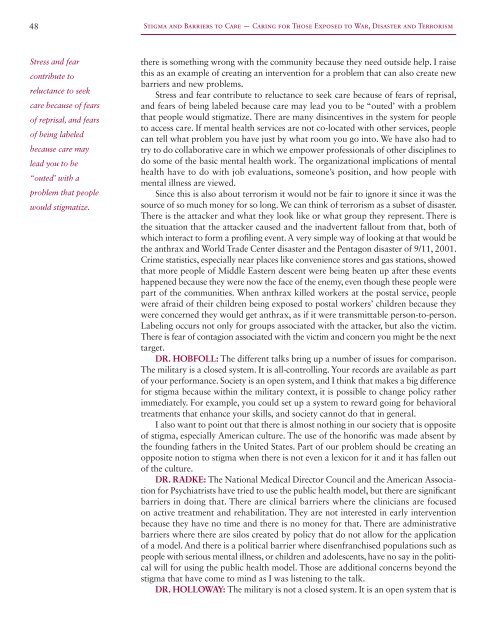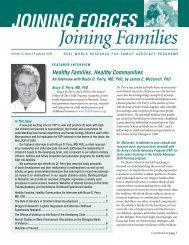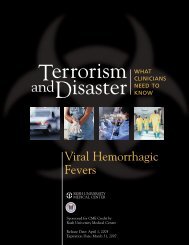stigma and barriers to care - Uniformed Services University of the ...
stigma and barriers to care - Uniformed Services University of the ...
stigma and barriers to care - Uniformed Services University of the ...
Create successful ePaper yourself
Turn your PDF publications into a flip-book with our unique Google optimized e-Paper software.
48<br />
Stigma <strong>and</strong> Barriers <strong>to</strong> Care — Caring for Those Exposed <strong>to</strong> War, Disaster <strong>and</strong> Terrorism<br />
Stress <strong>and</strong> fear<br />
contribute <strong>to</strong><br />
reluctance <strong>to</strong> seek<br />
<strong>care</strong> because <strong>of</strong> fears<br />
<strong>of</strong> reprisal, <strong>and</strong> fears<br />
<strong>of</strong> being labeled<br />
because <strong>care</strong> may<br />
lead you <strong>to</strong> be<br />
“outed’ with a<br />
problem that people<br />
would <strong>stigma</strong>tize.<br />
<strong>the</strong>re is something wrong with <strong>the</strong> community because <strong>the</strong>y need outside help. I raise<br />
this as an example <strong>of</strong> creating an intervention for a problem that can also create new<br />
<strong>barriers</strong> <strong>and</strong> new problems.<br />
Stress <strong>and</strong> fear contribute <strong>to</strong> reluctance <strong>to</strong> seek <strong>care</strong> because <strong>of</strong> fears <strong>of</strong> reprisal,<br />
<strong>and</strong> fears <strong>of</strong> being labeled because <strong>care</strong> may lead you <strong>to</strong> be “outed’ with a problem<br />
that people would <strong>stigma</strong>tize. There are many disincentives in <strong>the</strong> system for people<br />
<strong>to</strong> access <strong>care</strong>. If mental health services are not co-located with o<strong>the</strong>r services, people<br />
can tell what problem you have just by what room you go in<strong>to</strong>. We have also had <strong>to</strong><br />
try <strong>to</strong> do collaborative <strong>care</strong> in which we empower pr<strong>of</strong>essionals <strong>of</strong> o<strong>the</strong>r disciplines <strong>to</strong><br />
do some <strong>of</strong> <strong>the</strong> basic mental health work. The organizational implications <strong>of</strong> mental<br />
health have <strong>to</strong> do with job evaluations, someone’s position, <strong>and</strong> how people with<br />
mental illness are viewed.<br />
Since this is also about terrorism it would not be fair <strong>to</strong> ignore it since it was <strong>the</strong><br />
source <strong>of</strong> so much money for so long. We can think <strong>of</strong> terrorism as a subset <strong>of</strong> disaster.<br />
There is <strong>the</strong> attacker <strong>and</strong> what <strong>the</strong>y look like or what group <strong>the</strong>y represent. There is<br />
<strong>the</strong> situation that <strong>the</strong> attacker caused <strong>and</strong> <strong>the</strong> inadvertent fallout from that, both <strong>of</strong><br />
which interact <strong>to</strong> form a pr<strong>of</strong>iling event. A very simple way <strong>of</strong> looking at that would be<br />
<strong>the</strong> anthrax <strong>and</strong> World Trade Center disaster <strong>and</strong> <strong>the</strong> Pentagon disaster <strong>of</strong> 9/11, 2001.<br />
Crime statistics, especially near places like convenience s<strong>to</strong>res <strong>and</strong> gas stations, showed<br />
that more people <strong>of</strong> Middle Eastern descent were being beaten up after <strong>the</strong>se events<br />
happened because <strong>the</strong>y were now <strong>the</strong> face <strong>of</strong> <strong>the</strong> enemy, even though <strong>the</strong>se people were<br />
part <strong>of</strong> <strong>the</strong> communities. When anthrax killed workers at <strong>the</strong> postal service, people<br />
were afraid <strong>of</strong> <strong>the</strong>ir children being exposed <strong>to</strong> postal workers’ children because <strong>the</strong>y<br />
were concerned <strong>the</strong>y would get anthrax, as if it were transmittable person-<strong>to</strong>-person.<br />
Labeling occurs not only for groups associated with <strong>the</strong> attacker, but also <strong>the</strong> victim.<br />
There is fear <strong>of</strong> contagion associated with <strong>the</strong> victim <strong>and</strong> concern you might be <strong>the</strong> next<br />
target.<br />
DR. HOBFOLL: The different talks bring up a number <strong>of</strong> issues for comparison.<br />
The military is a closed system. It is all-controlling. Your records are available as part<br />
<strong>of</strong> your performance. Society is an open system, <strong>and</strong> I think that makes a big difference<br />
for <strong>stigma</strong> because within <strong>the</strong> military context, it is possible <strong>to</strong> change policy ra<strong>the</strong>r<br />
immediately. For example, you could set up a system <strong>to</strong> reward going for behavioral<br />
treatments that enhance your skills, <strong>and</strong> society cannot do that in general.<br />
I also want <strong>to</strong> point out that <strong>the</strong>re is almost nothing in our society that is opposite<br />
<strong>of</strong> <strong>stigma</strong>, especially American culture. The use <strong>of</strong> <strong>the</strong> honorific was made absent by<br />
<strong>the</strong> founding fa<strong>the</strong>rs in <strong>the</strong> United States. Part <strong>of</strong> our problem should be creating an<br />
opposite notion <strong>to</strong> <strong>stigma</strong> when <strong>the</strong>re is not even a lexicon for it <strong>and</strong> it has fallen out<br />
<strong>of</strong> <strong>the</strong> culture.<br />
DR. RADKE: The National Medical Direc<strong>to</strong>r Council <strong>and</strong> <strong>the</strong> American Association<br />
for Psychiatrists have tried <strong>to</strong> use <strong>the</strong> public health model, but <strong>the</strong>re are significant<br />
<strong>barriers</strong> in doing that. There are clinical <strong>barriers</strong> where <strong>the</strong> clinicians are focused<br />
on active treatment <strong>and</strong> rehabilitation. They are not interested in early intervention<br />
because <strong>the</strong>y have no time <strong>and</strong> <strong>the</strong>re is no money for that. There are administrative<br />
<strong>barriers</strong> where <strong>the</strong>re are silos created by policy that do not allow for <strong>the</strong> application<br />
<strong>of</strong> a model. And <strong>the</strong>re is a political barrier where disenfranchised populations such as<br />
people with serious mental illness, or children <strong>and</strong> adolescents, have no say in <strong>the</strong> political<br />
will for using <strong>the</strong> public health model. Those are additional concerns beyond <strong>the</strong><br />
<strong>stigma</strong> that have come <strong>to</strong> mind as I was listening <strong>to</strong> <strong>the</strong> talk.<br />
DR. HOLLOWAY: The military is not a closed system. It is an open system that is




